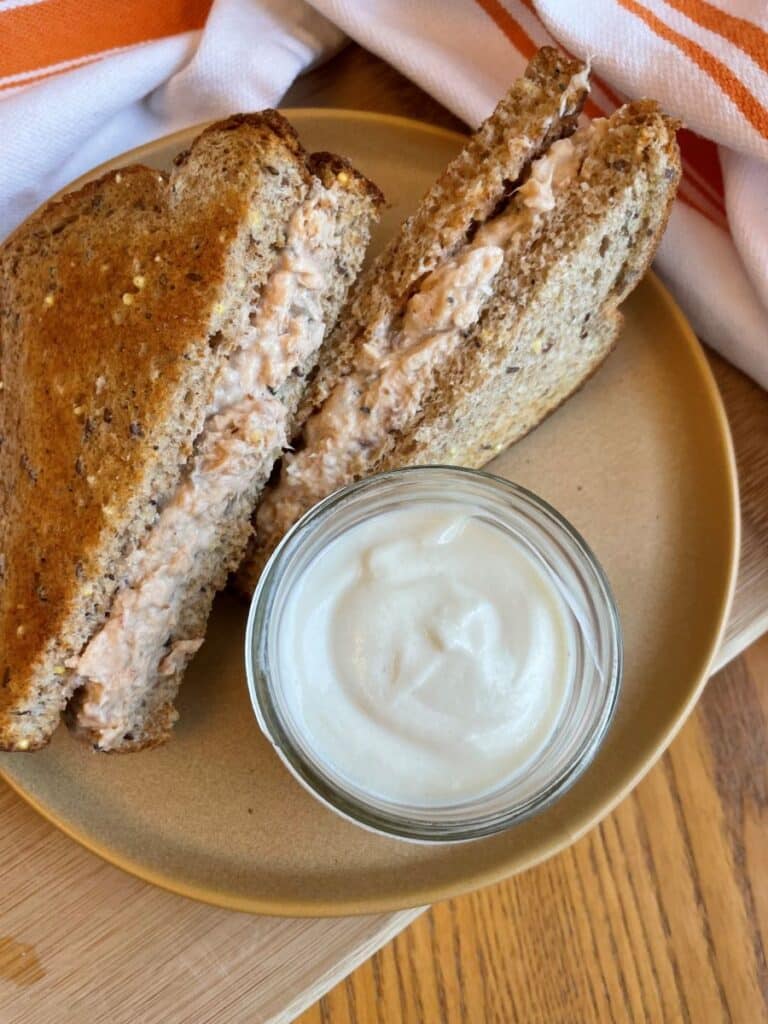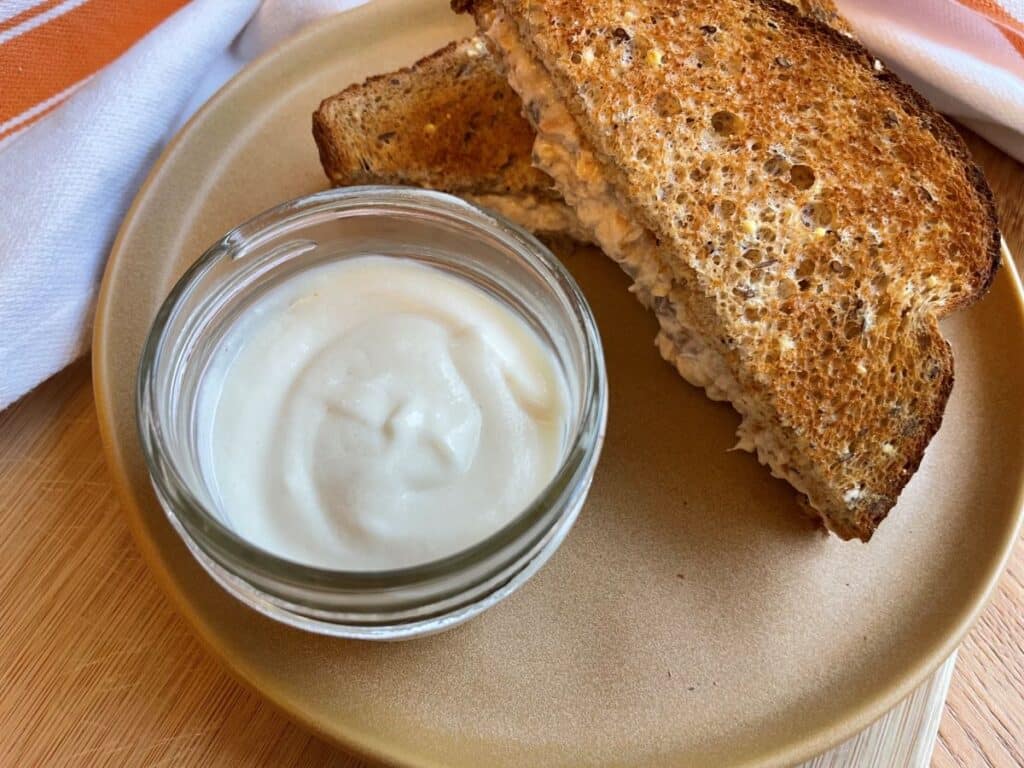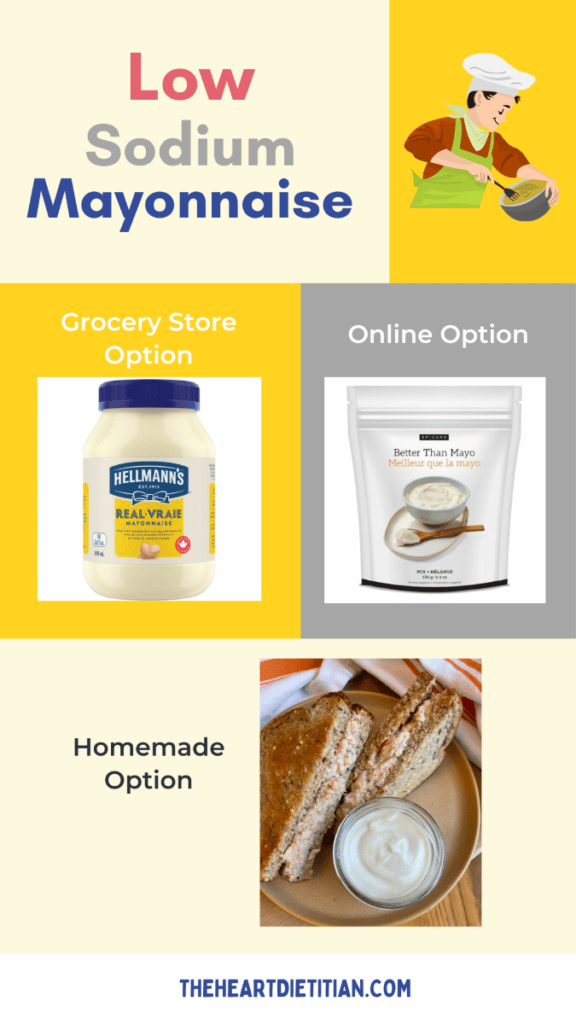If you love mayonnaise, you are probably wondering how mayonnaise can fit into a low-sodium eating pattern.
The average sodium in grocery store mayonnaise runs you around 135 mg per 1 tablespoon (tbsp), and a typical serving of mayo is more like 2 tbsp. That’s around 270 mg of sodium per portion of mayonnaise.
If you are following a low-sodium eating pattern, you are probably trying to consume around 1500 mg of sodium per day. If so, that 270 mg of sodium in the 2 tbsp of mayo makes up around 18% of your sodium intake just from a condiment!
As you can see, eating regular mayo really puts a dent in your daily sodium budget.
In this article, we’ll be reviewing some low-sodium mayonnaise options. As a dietitian, it is my duty to also recommend mayonnaise that uses healthy types of fat too.
Read on to find a mayonnaise that you can feel comfortable adding to your eating pattern.
*Please note that this post contains clearly identified affiliate links. If you click on these links and choose to make a purchase, I may receive a commission (at no cost to you). As an Amazon Associate, I earn from qualifying purchases.
Top Takeaways
- Regular mayonnaise is relatively high in sodium, with around 135 mg per 1 tablespoon (tbsp) serving. Given that a typical serving size is 2 tbsp, this amounts to approximately 270 mg of sodium, which can be a significant portion of your daily sodium intake, especially if you’re following a low-sodium diet of around 1500 mg per day.
- Low-sodium mayonnaise options are available for individuals who need to limit their sodium intake, such as those with high blood pressure or kidney issues. These alternatives typically contain reduced sodium levels compared to regular mayonnaise, making them a better choice for those on low-sodium diets.
- When choosing a healthy mayonnaise, it’s essential to consider not only the sodium content but also the type of fats used. Opt for mayonnaise made with heart-healthy oils like olive oil, avocado oil, or canola oil, as these provide unsaturated fats that can benefit your overall health.
- Some recommended low-sodium mayonnaise options include Better Than Mayo Mix By Epicure, Hellmann’s Real Mayonnaise (which surprisingly has lower sodium content), or making your own low-sodium mayonnaise at home using tofu, lemon juice, white wine vinegar, Dijon mustard, and a heart-healthy oil like avocado oil.

What Is Low Sodium Mayonnaise?
Mayonnaise is a condiment that is typically made from eggs, oil, and vinegar. When sold in the grocery store salt is usually added to the preparation of mayonnaise to enhance the taste and for preservation.
Mayonnaise is a delicious and simple addition to many dishes like:
- sandwich spreads like a classic tomato or a turkey burger
- a mean tuna salad
- aioli dip for fish, or roasted vegetables
- coleslaw or potato salad
- deviled eggs
- dips
- ranch dressing
Some individuals need to follow a low-sodium diet for blood pressure control, or optimal heart and kidney health. And thus, finding a low-sodium mayo alternative is highly recommended to stay within one’s daily sodium allowance.
What To Look For In A Healthy Mayonnaise
As a dietitian, I judged current mayonnaise options based on nutrition and ingredients. Because we don’t eat nutrients like sodium in isolation, when it comes to mayonnaise, we want to make sure we are eating the right type of fat too.
You may think the important nutrient to look at on the nutrition label is calories, but I’d suggest you do yourself a favor and skip that. Calories don’t provide a lot of information on what is actually in the mayonnaise. Instead, I recommending jumping right to the fat content to determine if it’s a healthy type of fat, and then check the amount of sodium to be sure it falls within your recommended daily limit.
Fat
I’m going to start with a controversial statement. Fat is okay to consume. If I had a nickel for every time I heard “I stopped eating mayonnaise because of its fat content”, I’d be rich!
Not all fat is bad. In fact, we need fat in our diet to help absorb fat-soluble vitamins, and it will actually help lower LDL (or bad) cholesterol levels. In fact, eating healthy mayonnaise can contribute to the recommended daily intake of olive oil a day in the Mediterranean diet.
That being said, not all fat is good. We want more unsaturated fats and less saturated fats to help manage our cholesterol levels. Reading the label helps us understand if the fat content is high in saturated fat or unsaturated fat.
Alternatively, you can read the ingredient list and make sure heart-healthy oils are used like olive oil, avocado oil, or canola oil. These oils should be listed as one of the first ingredients on the ingredient list.
Surprisingly many mayonnaise use soybean oil. Soybean oil is high in omega-6 fatty acids. Even though this is unsaturated fat, North Americans consume too much omega 6 fats, and not enough omega 3 fats throwing off the ratio and potentially aiding in the inflammatory process (1).
Thus, any mayonnaise label that used soybean oil, I didn’t include in my recommendation.
Sodium
Sodium, this is what you are here for! Finding a low-sodium mayonnaise. In my search, I found a range of commercial mayonnaises from 65 mg to 165 mg per serving, with the majority around 135 mg per 1 tbsp serving.
If you are on a low sodium diet, typically one of around 1500 mg of sodium per day, you really need to be careful about how much sodium you are consuming.
Interestingly, the labels that had nutrition claims on the front like “50% less sodium” often had a higher sugar content and were usually made with lower quality, unhealthy oils. Thus, they didn’t make the cut.
Additionally, another nutrition claim that was not so helpful on mayonnaise labels was “50% less fat” because often these products had the most sodium! I guess if you remove the fat, you remove the flavor and thus need to enhance its taste with something like salt.

Is Low Sodium Mayonnaise Worth Buying?
Generally, I would suggest purchasing low-sodium products, but it’s especially worth purchasing if you are following a low-sodium diet. When we eat mayonnaise we often use more than the 1 tbsp serving on the nutrition facts panel, and thus it quickly puts a dent into our daily sodium allowance.
For example, a 2 tbsp serving of the average sodium is 135 mg. If you are following a low sodium diet of 1500 mg, that’s 18% of your intake just from a condiment!
Say you want to make a heart-healthy tuna salad for lunch. Two slices of bread can run you around 300 mg of sodium, and if you add canned tuna (1/2 can haz around 320 mg of sodium), your meal of a healthy lunch is now 890 mg of sodium or 60% of your daily sodium intake.
As you can see your daily sodium can really add up, and thus it’s important to be aware and choose the low sodium alternatives when possible.
Low Sodium Mayo Alternatives
Want to skip mayonnaise altogether? Some low-sodium condiment alternatives you can use instead are:
- Olive oil or avocado oil
- Greek yogurt
- Avocado
- Homemade hummus
- Homemade pesto
Top 3 Picks From a Dietitian
1. Better Than Mayo Mix By Epicure (it’s vegan too!)
Ingredients: Linseed flour, organic cane sugar, sea salt, carrot fiber
Then when it’s time to make it (recipe here), you add water, oil, and apple cider vinegar.
Nutrition: Per 1 Tbsp Prepared (14 g): 90 calories, 10 g fat (0.5 g saturated fat, 0 g trans fat), 65 mg sodium, 0 g carbs (0 g fiber, 0 g sugar), 0 g protein
This interesting mayo is not what you typically pick up in the grocery store. It is the lowest sodium per tablespoon I have seen. In fact, it’s actually half the sodium than most mayonnaises sold at the grocery store AND it has more unsaturated fats than supermarket alternatives.
It is plant-based, vegan-friendly, and does not use any eggs. Thus low on cholesterol too.
I also love this product because you can choose the oil here!
As a bonus, this one pouch makes 10 cups of mayonnaise. This means, you only need to make the amount you need, and once prepared, the mayo keeps for 2 weeks in the refrigerator.
Where To Buy: This product is not sold in grocery stores. It is only sold and shipped directly to your door. If you are interested in learning more about this company check out my Epicure review for more information on their products.

2. Hellmann’s Real Mayonnaise
Nutrition: Per 1 Tbsp (14 g): 100 calories, 10 g fat (1 g saturated fat, 0 g trans fat), 95 mg sodium, 0g carbs (0 g fiber, 0 g sugar), 0.1 g protein.
Ingredients: Canola Oil, Water, Liquid Whole Egg Vinegar, Liquid Egg Yolk, Salt, Sugar, Spices, Concentrated Lemon Juice and Calcium Disodium EDTA (used to protect quality)
Who would have thought the traditional mayonnaise brand would be the lowest sodium at 95 mg per tablespoon?
Where To Buy: At your local supermarket or Amazon

3. Homemade Low Sodium Mayonnaise Recipe
And if you don’t like either option above, you can make your own low-salt mayonnaise. The mayo listed here has no added salt, and is vegan-friendly!
A homemade mayonnaise recipe I really enjoy is as follows. It’s easy and high in protein! I add chipotle to it for extra flavor but feel free to leave it out if you prefer plain or don’t like the spice.
This 5 ingredient, uber heart-healthy vegan, low sodium mayonnaise recipe takes no time to whip up. The secret ingredient is actually tofu. If you are new to using tofu, read more about how to purchase it here.
This lowest sodium mayonnaise is highly customizable. I’d suggest using fresh herbs and spices to enhance the flavor of mayonnaise since salt is not used for flavor. Other flavors to add are garlic, pepper, cayenne, red pepper flakes, ground mustard, paprika, or dill.
I’d choose either olive oil or avocado oil here. Feel free to read up on other alternatives to olive oil to see which one you prefer.
Ingredients:
- 1 cup of cubed soft tofu
- 1 tsp lemon juice
- 1 tsp white wine vinegar
- 1 tsp Dijon mustard
- 3/4 cup of avocado oil (as a milder flavor substitute for olive oil)
- optional (1 tsp chipotle powder)
Directions:
- Combine cubed tofu, lemon juice, white wine vinegar, chipotle pepper (if using), and Dijon mustard in a blender and blitz until combined.
- While the blender is on the lowest setting, slowly add avocado oil, as this helps with emulsification.
- Once it’s done, you should taste it. If necessary, you can add a little more lemon juice or vinegar to your liking.
- Place mayo in an air-tight container, and store it in the refrigerator for up to 2 weeks.
Makes 1 1/3rd cup of mayo
Nutrition: Per 1 Tbsp: 72 calories, 8 g fat (1 g saturated fat, 0 g trans fat), 3 mg sodium, 0.3 g carbs (0.2 g fiber, 0.1 g sugar), 1 g protein

Summary Of Mayonnaise Recommendations
| Hellmanns | Epicure | Homemade Reicpe | |
| Unsaturated Fat (g) | 9 | 9.5 | 7 |
| Sodium (mg) | 95 | 65 | 3 |
| Protein (g) | 0 | 0 | 1 |

Final Thoughts
It’s worth looking at the sodium content of mayonnaise when you are following a low-sodium diet for heart or kidney health.
Choose a low salt mayonnaise that fits your lifestyle, or try them all to find one you like best! Let me know in the comments which one you choose.
If you need more low sodium recipe inspiration check out low sodium breakfast ideas, low sodium lunch ideas, low sodium pasta recipes,low sodium bagels, low sodium tortillas,, low sodium instant pot recipes, low sodium hot chocolate, low sodium marinara sauce, low sodium pancakes, low sodium oatmeal recipes, low sodium salsa, low sodium hummus, low sodium taco seasoning, tofu bolognese… to name a few.
Interested in more meal ideas to lower your cholesterol and improve your blood pressure, try these oat bran recipes.? Subscribe to our monthly newsletter to download a 7-day heart-healthy meal plan.

